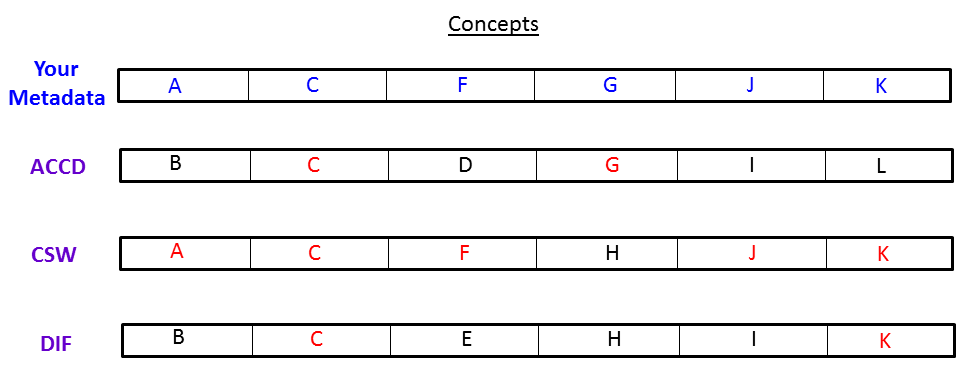Difference between revisions of "Documentation Guidance Methods"
| (22 intermediate revisions by 2 users not shown) | |||
| Line 1: | Line 1: | ||
| − | + | Deciding which metadata dialect is most appropriate for the metadata in question can be approached in two ways: | |
| − | |||
| − | + | == Option A - No Agreed Upon Best Practice== | |
| + | If there is no agreed upon “best practice” metadata dialect within the community that will be using the data, best approach is to evaluate which dialect contains the maximum required, recommended, and optional concepts as your metadata. This method minimizes the amount of your metadata that has to be changed for compatibility and therefore conserves time and effort. (See the Figure below for a visual example) | ||
| − | + | [[File:No best practice.png]] | |
| − | + | ||
| − | + | ''Note: CSW has 5 out of 6 concepts matching your metadata, whereas ACCD and DIF have only 2 matching concepts. Thus, the preferred choice in this case would be CSW, as only 1 concept requires modification in order to achieve compatibility.'' | |
| − | + | ||
| − | + | == Option B - Agreed Upon Best Pratice== | |
| − | + | If there is an agreed upon “best practice” metadata dialect within the community that will be using the data, that dialect should be chosen in order to remain consistent with accepted standards. In this case, the best approach is to evaluate which concepts your metadata already contains that are required, recommended, or optional for the mandatory metadata dialect and modify all others to achieve compatibility (See the Figure below for a visual example) | |
| − | + | ||
| − | + | [[File:best practice.png]] | |
| − | + | ||
| − | + | ''Note: DIF is the standard “best practice” metadata dialect within the community that will be using the data. 2 out of the 6 DIF concepts match your metadata, but the 1st, 3rd, 4th, and 5th concepts will have to be modified to achieve compatibility.'' | |
| − | + | ||
| − | + | ||
| − | + | [[Let's Start at the Beginning]] | |
| − | |||
| − | |||
| − | |||
| − | |||
| − | |||
| − | |||
| − | |||
| − | |||
| − | |||
| − | |||
| − | |||
| − | |||
| − | |||
| − | |||
| − | |||
| − | |||
| − | |||
| − | |||
| − | |||
| − | |||
| − | |||
| − | |||
| − | |||
| − | |||
| − | |||
| − | |||
| − | |||
| − | |||
| − | |||
| − | |||
| − | |||
| − | |||
| − | |||
| − | |||
| − | |||
| − | |||
| − | |||
| − | |||
| − | |||
| − | |||
| − | |||
| − | |||
| − | |||
| − | |||
| − | |||
| − | |||
| − | |||
| − | |||
| − | |||
| − | |||
| − | |||
| − | |||
| − | |||
| − | |||
| − | |||
| − | |||
| − | |||
| − | |||
| − | |||
| − | |||
| − | |||
| − | |||
| − | |||
| − | |||
| − | |||
| − | |||
| − | |||
| − | |||
| − | |||
| − | |||
| − | |||
| − | |||
| − | |||
| − | |||
Latest revision as of 11:40, July 29, 2015
Deciding which metadata dialect is most appropriate for the metadata in question can be approached in two ways:
Option A - No Agreed Upon Best Practice
If there is no agreed upon “best practice” metadata dialect within the community that will be using the data, best approach is to evaluate which dialect contains the maximum required, recommended, and optional concepts as your metadata. This method minimizes the amount of your metadata that has to be changed for compatibility and therefore conserves time and effort. (See the Figure below for a visual example)
Note: CSW has 5 out of 6 concepts matching your metadata, whereas ACCD and DIF have only 2 matching concepts. Thus, the preferred choice in this case would be CSW, as only 1 concept requires modification in order to achieve compatibility.
Option B - Agreed Upon Best Pratice
If there is an agreed upon “best practice” metadata dialect within the community that will be using the data, that dialect should be chosen in order to remain consistent with accepted standards. In this case, the best approach is to evaluate which concepts your metadata already contains that are required, recommended, or optional for the mandatory metadata dialect and modify all others to achieve compatibility (See the Figure below for a visual example)
Note: DIF is the standard “best practice” metadata dialect within the community that will be using the data. 2 out of the 6 DIF concepts match your metadata, but the 1st, 3rd, 4th, and 5th concepts will have to be modified to achieve compatibility.

